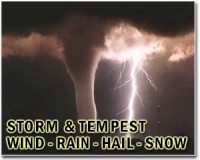| . |  |
. |
San Diego CA (SPX) Mar 09, 2011 A hurricane-like superstorm expected to hit California once every 200 years would cause devastation to the state's businesses unheard of even in the Great Recession, a USC economist warns. Researchers estimate the total property damage and business interruption costs of the massive rainstorm would be nearly $1 trillion. USC research professor Adam Rose calculated that the lost production of goods and services alone would be $627 billion of the total over five years. Rose, a professor with the USC School of Policy, Planning, and Development, also is the coordinator for economics at the Center for Risk and Economic Analysis of Terrorism Events (CREATE) at USC. That number would make the severe storm scenario "the costliest disaster in the history of the United States?, Rose said, more than six times greater than the 2001 World Trade Center attacks and Hurricane Katrina, which each caused $100 billion in business interruption. The storm simulation U.S. Geological Survey (USGS) scientists termed "ARkStorm - or "atmospheric river storm" - is patterned after the U.S. West Coast storms that devastated California in 1861-62. The storms lasted for 45 days, forming lakes in the Mojave Desert and the Los Angeles Basin. California was left bankrupt after the storms wiped out nearly a third of the state's taxable land, according to the USGS. But those storms were no freak event, said USGS scientists, who called the ARkStorm model "plausible, perhaps inevitable." The ARkStorm areas include Orange County, Los Angeles County, San Diego and the San Francisco Bay area. The megastorm likely would require the evacuation of 1.5 million people. According to the USGS, the ARkStorm would: + create hurricane-force winds of up to 125 miles per hour in some areas and flood thousands of square miles of urban and agricultural land to depths of 10 to 20 feet. + set off hundreds of landslides that would damage roads, highways and homes.? + disrupt lifelines such as power, water and sewers that would take weeks or months to repair. Rose estimated the ARkStorm would cause the state's unemployment rate to jump six percentage points in the first year, a further blow to the California economy that currently has one of the highest unemployment rates in the nation at 12.4 percent. Rose called the severe storm scenario "much more imaginable" after Los Angeles was hit with 9.42 inches of rain in December. It was the wettest December in downtown Los Angeles in more than a century. Climate scientists said global warming is a major factor behind the increasingly destructive power of hurricanes and other storms. The sea level is rising as oceans warm and glaciers melt, which can create higher storm surges and more disastrous flooding in coastal areas. "Climate change affects how the whole ecosystem works," said Mark Bernstein, managing director of The USC Energy Institute. "Storms form based on how warm the oceans are and how the jet stream changes," Bernstein said. "The consequence is [the rain] will come in shorter and more intense bursts." Businesses and local governments can minimize the long-term impacts of such a disaster, Rose said, by creating emergency plans, increasing inventories of critical materials, backing up information systems, and diversifying supply chains and routes.
Share This Article With Planet Earth
Related Links University of Southern California Weather News at TerraDaily.com
 'Superstorm' could devastate California
'Superstorm' could devastate CaliforniaLos Angeles (UPI) Mar 7, 2011 A superstorm that could hit California once every 200 years would devastate the state's economy worse than during the Great Recession, an economist says. Total property damage and business interruption costs of such a hurricane-like rainstorm would be nearly $1 trillion, researchers say. University of Southern California research Professor Adam Rose calculated the lost production of goo ... read more |
|
| The content herein, unless otherwise known to be public domain, are Copyright 1995-2010 - SpaceDaily. AFP and UPI Wire Stories are copyright Agence France-Presse and United Press International. ESA Portal Reports are copyright European Space Agency. All NASA sourced material is public domain. Additional copyrights may apply in whole or part to other bona fide parties. Advertising does not imply endorsement,agreement or approval of any opinions, statements or information provided by SpaceDaily on any Web page published or hosted by SpaceDaily. Privacy Statement |